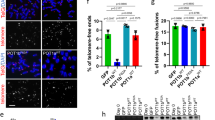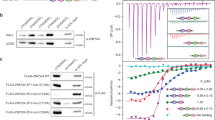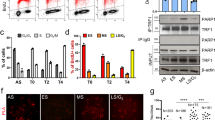Abstract
Telomere dysfunction may result in chromosomal abnormalities, DNA damage responses, and even cancer1. Early studies in lower organisms have helped to establish the crucial role of telomerase and telomeric proteins in maintaining telomere length and protecting telomere ends2,3,4,5,6,7. In Oxytricha nova, telomere G-overhangs are protected by the TEBP-α/β heterodimer3,4. Human telomeres contain duplex telomeric repeats with 3′ single-stranded G-overhangs, and may fold into a t-loop structure that helps to shield them from being recognized as DNA breaks8,9. Additionally, the TEBP-α homologue, POT1, which binds telomeric single-stranded DNA (ssDNA)10, associates with multiple telomeric proteins (for example, TPP1, TIN2, TRF1, TRF2 and RAP1) to form the six-protein telosome/shelterin11,12 and other subcomplexes. These telomeric protein complexes in turn interact with diverse pathways to form the telomere interactome13 for telomere maintenance. However, the mechanisms by which the POT1-containing telosome communicates with telomerase to regulate telomeres remain to be elucidated. Here we demonstrate that TPP1 is a putative mammalian homologue of TEBP-β and contains a predicted amino-terminal oligonucleotide/oligosaccharide binding (OB) fold. TPP1–POT1 association enhanced POT1 affinity for telomeric ssDNA. In addition, the TPP1 OB fold, as well as POT1–TPP1 binding, seemed critical for POT1-mediated telomere-length control and telomere-end protection in human cells. Disruption of POT1–TPP1 interaction by dominant negative TPP1 expression or RNA interference (RNAi) resulted in telomere-length alteration and DNA damage responses. Furthermore, we offer evidence that TPP1 associates with the telomerase in a TPP1-OB-fold-dependent manner, providing a physical link between telomerase and the telosome/shelterin complex. Our findings highlight the critical role of TPP1 in telomere maintenance, and support a yin–yang model in which TPP1 and POT1 function as a unit to protect human telomeres, by both positively and negatively regulating telomerase access to telomere DNA.
This is a preview of subscription content, access via your institution
Access options
Subscribe to this journal
Receive 51 print issues and online access
$199.00 per year
only $3.90 per issue
Buy this article
- Purchase on Springer Link
- Instant access to full article PDF
Prices may be subject to local taxes which are calculated during checkout




Similar content being viewed by others
References
Chadwick, D. J. & Cardew. G. (eds) Telomeres and Telomerase (John Wiley & Sons, Chichester, UK, 1997)
Gottschling, D. E. & Zakian, V. A. Telomere proteins: specific recognition and protection of the natural termini of Oxytricha macronuclear DNA. Cell 47, 195–205 (1986)
Greider, C. W. & Blackburn, E. H. The telomere terminal transferase of Tetrahymena is a ribonucleoprotein enzyme with two kinds of primer specificity. Cell 51, 887–898 (1987)
Gray, J. T., Celander, D. W., Price, C. M. & Cech, T. R. Cloning and expression of genes for the Oxytricha telomere-binding protein: specific subunit interactions in the telomeric complex. Cell 67, 807–814 (1991)
Lingner, J. & Cech, T. R. Telomerase and chromosome end maintenance. Curr. Opin. Genet. Dev. 8, 226–232 (1998)
Shore, D. Telomere length regulation: getting the measure of chromosome ends. Biol. Chem. 378, 591–597 (1997)
Bertuch, A. A. & Lundblad, V. The maintenance and masking of chromosome termini. Curr. Opin. Cell Biol. 18, 247–253 (2006)
Henderson, E., Hardin, C. C., Walk, S. K., Tinoco, I. & Blackburn, E. H. Telomeric DNA oligonucleotides form novel intramolecular structures containing guanine–guanine base pairs. Cell 51, 899–908 (1987)
Griffith, J. D. et al. Mammalian telomeres end in a large duplex loop. Cell 97, 503–514 (1999)
Baumann, P. & Cech, T. R. Pot1, the putative telomere end-binding protein in fission yeast and humans. Science 292, 1171–1175 (2001)
Liu, D., O'Connor, M. S., Qin, J. & Songyang, Z. Telosome, a mammalian telomere-associated complex formed by multiple telomeric proteins. J. Biol. Chem. 279, 51338–51342 (2004); published online 20 September 2004.
de Lange, T. Shelterin: the protein complex that shapes and safeguards human telomeres. Genes Dev. 19, 2100–2110 (2005)
Songyang, Z. & Liu, D. Inside the mammalian telomere interactome: regulation and regulatory activities of telomeres. Crit. Rev. Eukaryot. Gene Expr. 16, 103–118 (2006)
Nugent, C. I., Hughes, T. R., Lue, N. F. & Lundblad, V. Cdc13p: a single-strand telomeric DNA-binding protein with a dual role in yeast telomere maintenance. Science 274, 249–252 (1996)
Liu, D. et al. PTOP interacts with POT1 and regulates its localization to telomeres. Nature Cell Biol. 6, 673–680 (2004); published online 6 June 2004.
Ye, J. Z. et al. POT1-interacting protein PIP1: a telomere length regulator that recruits POT1 to the TIN2/TRF1 complex. Genes Dev. 18, 1649–1654 (2004); published online 1 July 2004.
Horvath, M. P., Schweiker, V. L., Bevilacqua, J. M., Ruggles, J. A. & Schultz, S. C. Crystal structure of the Oxytricha nova telomere end binding protein complexed with single strand DNA. Cell 95, 963–974 (1998)
Lei, M., Podell, E. R. & Cech, T. R. Structure of human POT1 bound to telomeric single-stranded DNA provides a model for chromosome end-protection. Nature Struct. Mol. Biol. 11, 1223–1229 (2004); published online 21 November 2004.
Yang, Q., Zheng, Y. L. & Harris, C. C. POT1 and TRF2 cooperate to maintain telomeric integrity. Mol. Cell. Biol. 25, 1070–1080 (2005)
Takai, H., Smogorzewska, A. & de Lange, T. DNA damage foci at dysfunctional telomeres. Curr. Biol. 13, 1549–1556 (2003)
d'Adda di Fagagna, F. et al. A DNA damage checkpoint response in telomere-initiated senescence. Nature 426, 194–198 (2003); published online 13 November 2005.
Wu, L. et al. Pot1 deficiency initiates DNA damage checkpoint activation and aberrant homologous recombination at telomeres. Cell 126, 49–62 (2006)
Hockemeyer, D., Daniels, J. P., Takai, H. & de Lange, T. Recent expansion of the telomeric complex in rodents: Two distinct POT1 proteins protect mouse telomeres. Cell 126, 63–77 (2006)
O'Connor, M. S., Safari, A., Xin, H., Liu, D. & Songyang, Z. A critical role for TPP1 and TIN2 interaction in high-order telomeric complex assembly. Proc. Natl Acad. Sci. USA 103, 11874–11879 (2006)
Houghtaling, B. R., Cuttonaro, L., Chang, W. & Smith, S. A dynamic molecular link between the telomere length regulator TRF1 and the chromosome end protector TRF2. Curr. Biol. 14, 1621–1631 (2004)
Loayza, D. & De Lange, T. POT1 as a terminal transducer of TRF1 telomere length control. Nature 424, 1013–1018 (2003)
Fang, G. & Cech, T. R. The β subunit of Oxytricha telomere-binding protein promotes G-quartet formation by telomeric DNA. Cell 74, 875–885 (1993)
Verdun, R. E., Crabbe, L., Haggblom, C. & Karlseder, J. Functional human telomeres are recognized as DNA damage in G2 of the cell cycle. Mol. Cell 20, 551–561 (2005)
Fang, G. & Cech, T. R. Oxytricha telomere-binding protein: DNA-dependent dimerization of the alpha and beta subunits. Proc. Natl Acad. Sci. USA 90, 6056–6060 (1993)
Chen, J. L. & Greider, C. W. Determinants in mammalian telomerase RNA that mediate enzyme processivity and cross-species incompatibility. EMBO J. 22, 304–314 (2003)
Acknowledgements
We thank J. L. Chen for kindly providing the HA–TERT and hTR plasmids and we thank A. Laegeler, K. Huang and L.-Y. Chen for help. This work was supported by awards to Z.S. and D.L. from NIH, the Department of Defense, the American Cancer Society, and the American Heart Association. Z.S. is a Leukaemia and Lymphoma Society Scholar.
Author information
Authors and Affiliations
Corresponding author
Ethics declarations
Competing interests
Reprints and permissions information is available at www.nature.com/reprints. The authors declare no competing financial interests.
Supplementary information
Supplementary Information
This file contains Supplementary Figures S1-S5 with legends supporting the model that TPP1 is a TEBP-β homologue that interacts and regulates POT1, Supplementary Methods with more detailed description of the methodologies and reagents used in the paper and Supplementary Notes which contain references cited in Supplementary Methods (PDF 1467 kb)
Rights and permissions
About this article
Cite this article
Xin, H., Liu, D., Wan, M. et al. TPP1 is a homologue of ciliate TEBP-β and interacts with POT1 to recruit telomerase. Nature 445, 559–562 (2007). https://doi.org/10.1038/nature05469
Received:
Accepted:
Published:
Issue Date:
DOI: https://doi.org/10.1038/nature05469
This article is cited by
-
G4-quadruplex-binding proteins: review and insights into selectivity
Biophysical Reviews (2022)
-
The landscape of aging
Science China Life Sciences (2022)
-
Structures of telomerase at several steps of telomere repeat synthesis
Nature (2021)
-
Gametes deficient for Pot1 telomere binding proteins alter levels of telomeric foci for multiple generations
Communications Biology (2021)
-
Distinct functions of POT1 proteins contribute to the regulation of telomerase recruitment to telomeres
Nature Communications (2021)
Comments
By submitting a comment you agree to abide by our Terms and Community Guidelines. If you find something abusive or that does not comply with our terms or guidelines please flag it as inappropriate.



